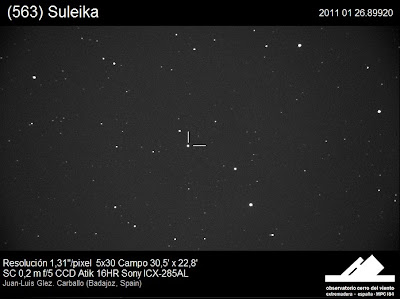long time I could not devote an entry to my beloved double stars. Finally it is time to resume my reports and speculations on this exciting topic.
Those who have read my brief biography of the English doubles player THECA Espin (1858-1934), published in the latest issue of The Double Star Observer (OED, No. 6, January-June 2011, pp. 104-112) , have already been informed of my intention to get involved in a titanic project is simply to measure all neglected double stars of the eminent astronomer. The total number of pairs found in this case over 400, so I have work ahead of them. I can anticipate that, at present, and having only 6 sessions dedicated to this task (this winter weather is not helping much), took 25% of the stars. However, it is the most difficult task: to process so much information.
Anyway, last Saturday I saw 12, the conditions were not too favorable: an Atlantic front is rough, the moon began to be really annoying and seeing as I saw then was not good . Somewhat pessimistic about what I could find, had prepared for the session of Espin only 10 stars, plus a few asteroids and supernovae.
Given the conditions above, splitting pairs cost me more closed than 4 ". To make matters worse, the characteristics of stars double espinianas not help much on nights like this: differences in magnitude of the components are usually always very high (about 3 or more).
Hardly were falling one after another when his turn came to ES 2621AH. Previously had not noticed the nomenclature of the par ... 2621AH! A double labeled as AH should be part of a truly complex. A quick check showed me the WDS on the march, which was before a group of double which had a long intra noteworthy and could see that indeed consisted of 9 components. I do not know if there are many multiple systems in such a large number of components, but of course I do not usually run into many of them, despite having some experience equally appealing.
Although I have not had time to process all the stars of this last observation session, this afternoon I caught the bug and wanted to study the case of ES 2621AH.
As you can see the list of WDS herein, the original pair is a comfortable and brilliant system catalog cataloged FGW Struve in 1830: STF 994AB. From there, one could almost say it's weird The doubles player in the late nineteenth century or early twentieth century that did not pass by and leave your two cents ... A. Ali, M. Bloch, J. Guillaume and G. Soulie, plus our T. Espin.
When one attacks a system like this is to hit the really complex to define each component of the group correctly. No choice but to be patient and to rule out one after another until it reaches the exact composition. The magnitudes are very helpful, despite all the mistakes that can contain, photometrically speaking, the WDS. I attached an outline of it so that you aclaréis.
In this case, last but not least, there was something in some components that do not allow me to balance the scheme quickly. AH component, that of Espin precisely not appear anywhere. Not be separated as comfortable (9.1 "according to the original size of 1892) think that had been overshadowed by the proper motion of one of the stars A and B. But it was not the case. Do not deny that at one point I started to get a little crazy because Espin was a real astronomer methodical and measured nearly 100 pairs so far have not found a single error in their data. Where was the component AH noses?
Unexpectedly I noticed that the AC component (ALI 574AC) had a nearly identical separation (9.6 "versus the 9.1" by AH). And the angle was suspiciously similar position: 120 º for AC compared with 221 º of HA. Eureka! Everything seemed clear on one point: surely these are the same stars and Espin wrong angle in a digit, went on to score 121 º 221 º (or it was a misprint.) There was only one possible check to make sure that this could be the correct explanation of the small mystery: compare your magnitudes. And all fits to perfection: the component C (the measure ALI) is 12.8 and the H (ES) is 12.
I do not quite clear is why the pair AH Espin is called when it was measured 8 years prior to that of Ali (1892 versus 1900). One possible explanation is that in 2005 someone measured the system and chose to assimilate to the extent of A. Ali, remaining for Neglected Espin as today.
Mystery Solved: the stars C and H of the system are the same . Anyway, I sent the request to the USNO to send me all historical measures of torque and, thus, confirm this curious story, of course, will be duly published in the next issue of OED with a handful of measures dear Espin.
Once demonstrates the important work of amateur astronomers dedicated to observe double stars: debug errors WDS is practically in our hands. These stars had waited for over 120 years for someone to solve the riddle star.
I hope your comment.
PS: Earlier I mentioned that I spent too much of the night to take some asteroids and supernovae ... Well, I can confirm that with integrations of 60 seconds I got to catch a quick boulder the size 17 ... From the polluted skies of Badajoz! This promises.










